**Russia Upgrades Ballistic Missiles, Complicating Ukraine’s Air Defense**
The situation in Ukraine has just gotten more complicated. According to Yuriy Ihnat, the Head of Communications Directorate of the Air Force Command of the Armed Forces of Ukraine, Russia has upgraded its ballistic missiles used to attack Ukraine. This upgrade has made it harder for air defense systems to intercept these missiles.
**A New Challenge for Air Defense**
Ihnat explained that the modernized Iskander-M missiles can now release radar decoys as they approach their target. This means that the missiles are becoming increasingly difficult to track and intercept. Additionally, the missiles’ ability to perform maneuvers during flight has made it harder for systems like Patriot to predict and calculate the interception point.
**A Threat to Ukraine’s Air Defense**
The upgrade of these ballistic missiles poses a significant threat to Ukraine’s air defense capabilities. While Ihnat emphasized that this does not make it impossible to intercept these missiles, it certainly makes it more challenging. The ability of air defense systems like Patriot to protect Ukrainian citizens and infrastructure is being tested by the enemy’s new tactics.
**A Massive Attack on Kyiv**
Just last night, Russia carried out one of its most massive attacks on Kyiv, using both ballistic missiles and drones simultaneously. 14 Iskander-M/KN-23 missiles and 250 attack drones were launched across Ukraine. The air defense forces managed to destroy six missiles and neutralize 245 drones.
**What’s Next?**
The upgrade of Russia’s ballistic missiles has raised the stakes in this conflict. Will Ukraine’s air defense systems be able to keep up with these new challenges? It seems that both sides are engaged in a cat-and-mouse game, with each side trying to outsmart and outmaneuver the other.
Read More @ ukrainefrontlines.com












